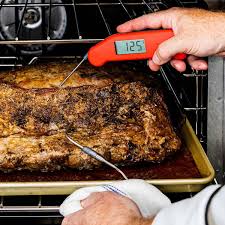The Best Smart Thermometers for Cooking: When it comes to precision cooking, especially for grilling, roasting, or sous vide, a smart thermometer can be a game-changer. Forget constantly opening the oven or standing over the grill these devices let you monitor temperatures right from your phone, ensuring perfectly cooked meals every time.

In this guide, we’ll dive deep into why smart thermometers are essential, what features to look for, the best models in 2025, and answer all your pressing questions.
Why You Need a Smart Thermometer
Traditional meat thermometers work, but smart thermometers bring a new level of convenience and precision to your cooking:
- Remote Monitoring: Check your food’s temperature from your phone, whether you’re inside, outside, or even running errands.
- Real-Time Alerts: Receive notifications when your food reaches the perfect doneness.
- Multiple Probes: Monitor different dishes or multiple parts of one dish simultaneously.
- Guided Cooking: Apps provide step-by-step instructions and ideal temperature settings.
- Data Tracking: Save cooking history for better results next time.
Whether you’re a casual cook, a backyard BBQ enthusiast, or a gourmet chef, a smart thermometer will elevate your game.
Key Features to Look For
Before purchasing a smart cooking thermometer, here’s what you should consider:
1. Wireless vs. Wired Probes
- Wireless Probes (like the MEATER series) offer complete freedom with no cables getting in the way—perfect for grilling and rotisserie cooking.
- Wired Probes are traditional but reliable, often more affordable and durable.
Tip: If you hate managing wires while cooking, go wireless. Otherwise, wired probes can handle higher temperatures more consistently.
2. Temperature Accuracy
Accuracy is crucial, especially when cooking meats like chicken or pork where safety is critical.
- Look for models with ±1°F accuracy.
- Faster readings (within 2–3 seconds) are better for busy kitchens.
Tip: A slight temperature miss can mean the difference between juicy perfection and overcooked dryness!
3. App Quality and Connectivity
You’ll be relying on the app a lot, so it needs to be user-friendly.
- Wi-Fi Connectivity lets you monitor temperatures even when you’re not at home.
- Bluetooth-Only Models work within a 100–500 ft range depending on interference.
Tip: Some models offer cloud-connected apps that let you monitor remotely from anywhere.
4. Battery Life
- Wireless probes need excellent battery life—look for 24+ hours on a full charge.
- Base units should have long battery life or the ability to plug into AC power.
Tip: Some thermometers come with rechargeable probes; others require disposable batteries.
5. Durability and Heat Resistance
A good smart thermometer should withstand:
- High cooking temperatures (up to 500°F or more)
- Water resistance (especially if you grill outdoors or sous vide)
6. Number of Probes
- Single Probe: Best for small meals.
- Multiple Probes (up to 4+): Ideal for BBQ, smoker setups, or holiday feasts.
Tip: Some apps allow you to assign different foods (like turkey, beef, and veggies) to different probes for better tracking.
READ ALSO: Essential Accessories for Your Xbox or PlayStation Console
Detailed Breakdown of Top Picks
MEATER Block
- Pros: 100% wire-free, fantastic app, customizable alerts, Cloud monitoring, rechargeable probes.
- Cons: Expensive, slight learning curve.
ThermoPro TempSpike
- Pros: Affordable wireless alternative, 500-ft Bluetooth range, fast accurate readings.
- Cons: App isn’t as polished as MEATER’s.
Weber Connect Smart Grilling Hub
- Pros: Great for BBQ, large display, weather-resistant body.
- Cons: Better suited for outdoor use.
Inkbird IBT-4XS
- Pros: Budget-friendly, handles multiple dishes at once, long battery life.
- Cons: Bluetooth-only connectivity (no remote cloud access).
Yummly Smart Thermometer
- Pros: Sleek design, easy app integration with cooking tips, perfect for kitchen ovens.
- Cons: Limited probe slots (single probe only).
Pro Tips for Using Your Smart Thermometer
- Calibrate your thermometer occasionally using ice water and boiling water.
- Insert probes into the thickest part of the meat, avoiding bones and fat pockets.
- Don’t leave it too close to an open flame unless it’s rated for very high temperatures.
- Keep your app updated—many brands issue firmware updates that improve reliability.
- Set both target temperature and ambient temperature alerts (especially for smokers).
FAQs
Are smart thermometers better than instant-read thermometers?
They serve different purposes. Instant-read thermometers are great for quick checks. Smart thermometers monitor temperatures continuously and alert you when food is ready, giving you more freedom during long cooks.
What’s the advantage of multiple probes?
Multiple probes allow you to track different foods simultaneously, or monitor internal and ambient temperatures at the same time. Essential for BBQing and multitasking.
How accurate are smart thermometers?
Top models are accurate to within ±1°F. For professional-level cooking, this kind of precision is extremely important, especially for meats like poultry, steak, and fish.
Can I use a smart thermometer for baking?
Absolutely. Smart thermometers are great for monitoring baked goods like bread, ensuring proper doneness without guesswork.
Do I need Wi-Fi to use a smart thermometer?
No, but Wi-Fi expands your range. Bluetooth-only models are limited to about 100–500 feet, while Wi-Fi-connected thermometers allow monitoring from anywhere via the internet.
How do I clean my smart thermometer probes?
Wipe the metal probe with a damp cloth or sponge. Do not submerge wireless probes unless they’re explicitly waterproof. Avoid getting the electronic parts wet.
Are smart thermometers worth the investment?
If you regularly cook meats, bake, or grill, absolutely. The improved precision, convenience, and reduced stress easily justify the cost over time.